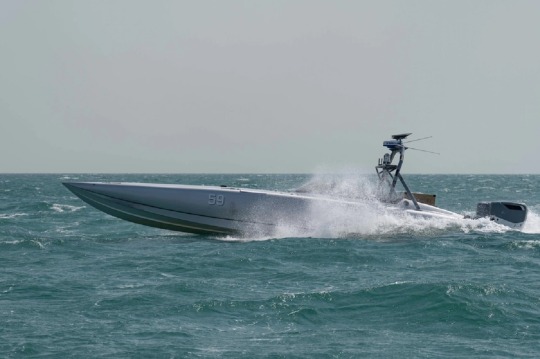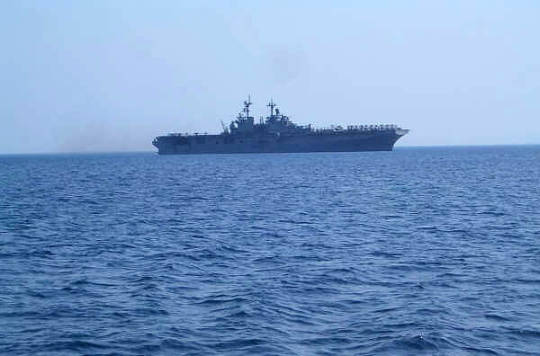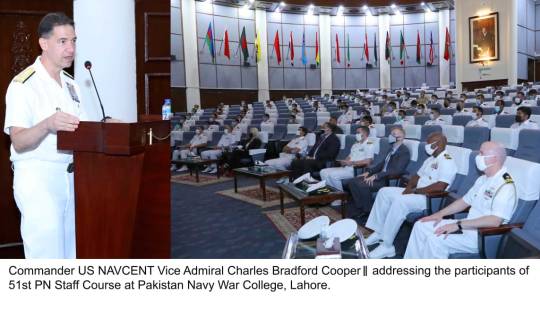#NAVCENT
Explore tagged Tumblr posts
Text
NAVCENT Commander Vice Admiral Brad Cooper Holds An Off-Camera, On-The-R ecord Press Briefing Via Teleconference on Operation Prosperity Guardian
View Online NAVCENT Commander Vice Admiral Brad Cooper Holds An Off-Camera, On-The-Record Press Briefing Via Teleconference on Operation Prosperity Guardian Jan. 4, 2024 MAJOR GENERAL PAT RYDER: Good morning, everyone. Thanks very much for joining us today for this backgrounder on Operation Prosperity Guardian. I’m Major General Pat Ryder, Pentagon press secretary. I’ll be facilitating today’s…

View On WordPress
0 notes
Text
US Naval Forces Central Command Unmanned Surface Vessels Fire Weapons at Sea
U.S. Naval Forces Central Command (NAVCENT) is advancing lethality and the combat capabilities of unmanned surface vehicles (USVs) during live weapons firing exercises in the international waters surrounding the Arabian Peninsula, Oct. 23. The firing exercises were conducted as part of Exercise Digital Talon and constituted the first use of lethal munitions from USVs in the Middle East region. During the exercise, NAVCENT’s Task Force 59, the Navy’s first Unmanned and Artificial Intelligence Task Force, demonstrated the ability of unmanned platforms to pair with traditionally crewed ships in “manned-unmanned teaming” to identify and target simulated hostile forces at sea. The hostile forces were represented through the use of a target boat. Then, using live munitions launched from another unmanned platform, NAVCENT forces engaged and destroyed the targets.
U.S. Naval Forces Central Command (NAVCENT) is advancing lethality and the combat capabilities of unmanned surface vehicles (USVs) during live weapons firing exercises in the international waters surrounding the Arabian Peninsula, Oct. 23. The firing exercises were conducted as part of Exercise Digital Talon and constituted the first use of lethal munitions from USVs in the Middle East region.…

View On WordPress
0 notes
Photo

October 2010... Legends of Aerospace ! Between October 9 & 11, 2010, three Apollo era astronauts visited US Naval Forces NAVCENT in Bahrein; Apollo 11 commander Neil Armstrong, Apollo 13 commander James Lovell and Apollo 17 commander Eugene Cernan... Legends of Aerospace ! Apollo 11 commander Neil Armstrong wore a Purdue University quartz wristwatch, Apollo 17 Eugene Cernan wore an Omega X-33 Speedmaster while Apollo 13 James Lovell wore his trusty Rolex GMT-master 1675 pilot watch on presidential bracelet. (Photo: US Navy)
#Astronaut#Aviator#ASE#Rolex#GMT-master#Omega Speedmaster#X33#1675#pilot watch#Purdue#military#montres#uhren#wristwatch#NASA#Navy#US Navy#NAVCENT#Moonwatch#MoonwatchUniverse#spaceflight
33 notes
·
View notes
Photo

COMMANDER US NAVCENT MEETS NAVAL CHIEF
Commander of US Naval Forces Central Command (NAVCENT) Vice Admiral C.B Cooper II called on Chief of the Naval Staff, Admiral Muhammad Amjad Khan Niazi at Naval Headquarters, Islamabad.
During the meeting, matters related to maritime security in the Indian Ocean Region and mutual interest including bilateral naval collaboration were discussed.
Pakistan Navy has been a regular contributor to the Combined Maritime Forces since 2004 and has also commanded Multinational Combined Task Forces 150 & 151, eleven and nine times respectively.
5 notes
·
View notes
Video
U.S. Naval Forces Central Command (NAVCENT), U.S. 5th Fleet and Combined Maritime Forces (CMF) holds a change of command at Naval Support Activity Bahrain. by Official U.S. Navy Page Via Flickr: NAVAL SUPPORT ACTIVITY BAHRAIN (May 5, 2021) Vice Adm. Sam Paparo, left, commander of U.S. Naval Forces Central Command (NAVCENT), U.S. 5th Fleet and Combined Maritime Forces (CMF), is relieved by Vice Adm. Brad Cooper, right, during a change of command ceremony presided over by Gen. Frank McKenzie, commander of U.S. Central Command, at Naval Support Activity Bahrain, May 5, 2021. NAVCENT is the U.S. Navy element of U.S. Central Command in the U.S. 5th Fleet area of operations and encompasses about 2.5 million square miles of water area and includes the Arabian Gulf, Gulf of Oman, Red Sea and parts of the Indian Ocean. The expanse is comprised of 20 countries and includes three critical choke points at the Strait of Hormuz, the Suez Canal and the Strait of Bab al Mandeb at the southern tip of Yemen. (U.S. Navy photo by Mass Communication Specialist 1st Class Daniel Hinton) 210505-N-KC128-0168
#U.S. 5th Fleet#USCENTCOM#CENTCOM#NAVCENT#C5F#CMF#NMCS#DVIDS Bulk Import#NAVAL SUPPORT ACTIVITY BAHRAIN#Bahrain
1 note
·
View note
Video
USS Nimitz (CVN 68), USS John Paul Jones (DDG 53), and USS Princeton (CG 59) transit the Strait of Hormuz. by Official U.S. Navy Page Via Flickr: STRAIT OF HORMUZ (Nov. 9, 2020) The aircraft carrier USS Nimitz (CVN 68), guided-missile destroyer USS John Paul Jones (DDG 53), center, and the guided-missile cruiser USS Princeton (CG 59) sail in formation during a scheduled transit of the Strait of Hormuz, Nov. 9, 2020. The Nimitz Carrier Strike Group is deployed to the U.S. 5th Fleet area of operations in support of naval operations to ensure maritime stability and security in the Central Region, connecting the Mediterranean and Pacific through the western Indian Ocean and three critical chokepoints to the free flow of global commerce. With Nimitz as the flagship, deployed strike group assets include staff, ships and aircraft of Carrier Strike Group 11, Destroyer Squadron 9, Princeton and Carrier Air Wing 17. (U.S. Navy photo by Mass Communication Specialist 3rd Class Anthony Collier) 201109-N-FP334-1063
#Maiden Deployment#Ralph Johnson#Destroyer#CENTCOM#USCENTCOM#USCENTCOMPA#NAVCENT#C5F#Princeton#JPJ#John Paul Jones#Nimitz#CSG11#NMCS#DVIDS Bulk Import#Strait of Hormuz
1 note
·
View note
Video
USS Nimitz (CVN 68), USS John Paul Jones (DDG 53), and USS Princeton (CG 59) transit the Strait of Hormuz. by Official U.S. Navy Page Via Flickr: STRAIT OF HORMUZ (Nov. 9, 2020) The aircraft carrier USS Nimitz (CVN 68), guided-missile destroyer USS John Paul Jones (DDG 53), center, and the guided-missile cruiser USS Princeton (CG 59) sail in formation during a scheduled transit of the Strait of Hormuz, Nov. 9, 2020. The Nimitz Carrier Strike Group is deployed to the U.S. 5th Fleet area of operations in support of naval operations to ensure maritime stability and security in the Central Region, connecting the Mediterranean and Pacific through the western Indian Ocean and three critical chokepoints to the free flow of global commerce. With Nimitz as the flagship, deployed strike group assets include staff, ships and aircraft of Carrier Strike Group 11, Destroyer Squadron 9, Princeton and Carrier Air Wing 17. (U.S. Navy photo by Mass Communication Specialist 3rd Class Anthony Collier) 201109-N-FP334-1063
#Maiden Deployment#Ralph Johnson#Destroyer#CENTCOM#USCENTCOM#USCENTCOMPA#NAVCENT#C5F#Princeton#JPJ#John Paul Jones#Nimitz#CSG11#NMCS#DVIDS Bulk Import#Strait of Hormuz#Now Playing#11th#November#2020#November 11th 2020
1 note
·
View note
Photo

“Out of many one.” #bahrain #navcent #nsabahrain #nctsbahrain #plankowner Flashback Friday: 2004 Bahrain Information Technology Center #usnavy #it #sandiego #realtor #usnavycpo #retired #veteran (at Mountain Hawk Park) https://www.instagram.com/p/CD5XEoTDg-j/?igshid=tcpsyyhecv7o
#bahrain#navcent#nsabahrain#nctsbahrain#plankowner#usnavy#it#sandiego#realtor#usnavycpo#retired#veteran
0 notes
Video
An F/A-18E Super Hornet launches from the flight deck of USS Abraham Lincoln (CVN 72). por Official U.S. Navy Page Por Flickr: ARABIAN SEA (Sept. 16, 2019) An F/A-18E Super Hornet attached to the Sidewinders of Strike Fighter Squadron (VFA) 86 launches from the flight deck of the aircraft carrier USS Abraham Lincoln (CVN 72). The Abraham Lincoln Carrier Strike Group is deployed to the U.S. 5th Fleet area of operations in support of naval operations to ensure maritime stability and security in the Central Region, connecting the Mediterranean and the Pacific through the western Indian Ocean and three strategic choke points. With Abraham Lincoln as the flagship, deployed strike group assets include staffs, ships and aircraft of Carrier Strike Group (CSG) 12, Destroyer Squadron (DESRON) 2, the guided-missile cruiser USS Leyte Gulf (CG 55) and Carrier Air Wing (CVW) 7. (U.S. Navy photo by Mass Communication Specialist 3rd Class Michael Singley/Released)190916-N-MM912-3028
#USS Abraham Lincoln (CVN 72); Navy; CVN 72; deployment; CENTCOM; USCENTCOM; NAVCENT; C5F; CENTCOMPA#ARABIAN SEA
3 notes
·
View notes
Text
US trials Stinger II gunships in anti-surface warfare role
Gareth Jennings, London - Jane's Defence Weekly
15 March 2020

The US military is trialling the use of the Lockheed Martin AC-130W Stinger II gunship in the anti-surface warfare (ASuW) role in the Middle East.
The Department of Defense (DoD) announced on 15 March that US Navy (USN) Cyclone-class patrol coastal ships (PC) and Boeing P-8A Poseidon maritime multimission aircraft (MMA) assigned to US Naval Forces Central Command (NAVCENT) had conducted "a first-of-its-kind" joint exercise with US Air Force (USAF) AC-130W gunships assigned to Special Operations Command Central (SOCCENT) on 8 and 9 March.
According to the DoD, the exercises were designed to enhance the capabilities of US forces to respond to surface threats and involved P-8 aircraft performing long-range reconnaissance ahead of PCs selecting simulated surface targets for the AC-130W to engage.
"This exercise mark[ed] the first time these assets ha[d] been integrated in direct support of maritime security operations in the Arabian Gulf," the DoD said.
The AC-130W Stinger II (formerly known as Dragon Spear) is a gunship-variant of the C-130 Hercules transport aircraft and is flown by the Air Force Special Operations Command (AFSOC). It is armed with a GAU-23 Bushmaster 30 mm cannon, a 105 mm gun, and stand-off precision-guided munitions such as the Boeing GBU-39 Small Diameter Bomb (SDB) and Raytheon's AGM-176A Griffin missile. AFSOC has 12 such aircraft in its inventory, flying alongside C-130-gunship variants such as the AC-130J Ghostrider.
These joint exercises are in support of the USN's Destroyer Squadron (DESRON) 50/Combined Task Force (CTF) 55, which conducts maritime security operations in support of regional security and stability in the 5th Fleet's area of responsibility (AoR) that encompasses about 6.5 million km 2 across the Gulf, Arabian Sea, Gulf of Oman, Red Sea, and parts of the Indian Ocean.
13 notes
·
View notes
Text
Operation Prosperity Guardian: Global Maritime Safety

Introduction to Operation Prosperity Guardian
In an insightful off-camera, on-the-record press briefing, Vice Admiral Brad Cooper, Commander of the United States Naval Forces Central Command (NAVCENT), provided a comprehensive overview of Operation Prosperity Guardian. This operation, initiated by the United States and its allies, is a strategic response to the escalating threats in the Red Sea and Gulf of Aden, regions of immense importance to global trade and security. The briefing highlighted the international nature of these maritime challenges and the necessity for a robust, collaborative response to ensure the safety of these crucial waterways.
The Threat to International Shipping
The need for Operation Prosperity Guardian has become increasingly urgent due to the heightened threat of Houthi missile attacks. These attacks not only pose a significant danger to international shipping but also threaten the safety of mariners and the global supply chain. Vice Admiral Cooper's briefing underscored the far-reaching implications of these attacks, noting their indiscriminate nature and the potential for severe disruptions in global trade routes. The attacks, contrary to international law, have necessitated a decisive response to maintain maritime security and uphold the principles of free navigation. Global Impact and Response Vice Admiral Cooper's briefing made it clear that the implications of these attacks are not limited to a single region or nation. With 55 countries directly linked to the ships targeted in these attacks, the ripple effects are indeed global. Recognizing this, the United States, under the leadership of Vice Admiral Cooper, has spearheaded an international response, rallying nations around the world to join forces in Operation Prosperity Guardian. This collective effort aims to mitigate the threats and maintain stability in these pivotal maritime routes.
The Role of Multinational Naval Force
A key focus of Vice Admiral Brad Cooper's briefing was the critical role played by the multinational naval force. This force, comprising 39 nations, demonstrates an unprecedented level of international cooperation and commitment. The establishment of Task Force 153, a part of this operation, is a testament to the global community's determination to protect these vital shipping lanes. The task force's operations are aimed at deterring illegal activities, ensuring safe passage for all vessels, and responding to any threats in a coordinated and effective manner. The Success of Operation Prosperity Guardian Since the launch of Operation Prosperity Guardian, there have been significant strides in enhancing maritime security. The operation's success is evident in the reduction of Houthi UAV and missile attacks in the region. This is a direct result of the deterrent presence of the multinational naval force and their active defense measures. The expansion of the coalition, now with 22 contributing countries, and the heightened engagement with the shipping industry, have been crucial to the operation's effectiveness. This has not only enhanced security but also reassured the international maritime community of the coalition's commitment to protecting these strategic waterways.
The Future of Maritime Security
Looking ahead, Vice Admiral Cooper expressed optimism about the future of maritime security in the region. Significantly, the operation's ongoing success is a beacon of hope for sustained peace and stability in these critical maritime routes. Additionally, the proactive and defensive stance of the international forces, coupled with their active presence, has been instrumental in deterring potential threats. Furthermore, the ongoing commitment from various nations to contribute resources and expertise to this cause is a positive indicator of the international community's resolve. This commitment underscores the shared understanding of the importance of maintaining peace and security in these vital waterways. Consequently, this multinational effort exemplifies how collaborative action can lead to significant strides in safeguarding crucial global interests.
Conclusion
Operation Prosperity Guardian, spearheaded by the United States under the leadership of Vice Admiral Brad Cooper, stands as a shining example of international unity and cooperation against global maritime threats. This operation extends beyond mere military action; indeed, it symbolizes a deep commitment to upholding international law, ensuring the safety of global shipping lanes, and fostering a secure environment for international trade. Moreover, the strong partnerships and collaborative efforts of the multinational naval force are crucial in maintaining peace and stability in these critical areas. Furthermore, these efforts are essential for the prosperity of nations worldwide, highlighting the operation's global significance and impact. Sources: THX News & US Department of Defence. Read the full article
#GulfofAden#Houthimissileattacks#Internationalmaritimecooperation#Internationalshipping#Maritimeexercise#Maritimesecurity#Multinationalnavalforce#RedSeasecurity#Shippinglanesafety#ViceAdmiralBradCooper
0 notes
Text
US Navy intercepts more than 50 tons of munitions allegedly bound for Yemen
US Navy intercepts more than 50 tons of munitions allegedly bound for Yemen
Interception of ammunition bound for Yemen by the US Navy – NAVCENT PUBLIC AFFAIRS The US Navy’s Fifth Fleet has announced the interception of more than 50 tons of munitions concealed on a fishing boat en route to Yemen. The operation took place on December 1 and was carried out by the crew of the expeditionary mobile base ship ‘USS Lewis B. Puller’ during a verification maneuver. The shipment…
View On WordPress
0 notes
Photo


Commander US NAVCENT visit to Pakistan Navy War College Lahore
0 notes
Video
USS Dwight D. Eisenhower (CVN 69) conducts flight operations in the Arabian Sea. by Official U.S. Navy Page Via Flickr: ARABIAN SEA (May 9, 2021) An F/A-18F Super Hornet attached to the "Fighting Swordsmen" of Strike Fighter Squadron (VFA) 32 launches from the flight deck of the aircraft carrier USS Dwight D. Eisenhower (CVN 69) during flight operations in the Arabian Sea, May 9, 2021. The Dwight D. Eisenhower Carrier Strike Group is deployed to the U.S. 5th Fleet area of operations in support of naval operations and providing airpower to protect U.S. and coalition forces as they conduct drawdown operations from Afghanistan. (U.S. Navy photo by Mass Communication Specialist Seaman Orion K. Shotton) 210509-N-GG032-2437
#USS Dwight D. Eisenhower; CVN 69; CENTCOM; USCENTCOM; USCENTCOMPA; NAVCENT; C5F; Afghanistan#NMCS#DVIDS Bulk Import#ARABIAN SEA
25 notes
·
View notes
Text
0 notes
Video
An F/A-18E Super Hornet prepares to launch from USS Harry S. Truman (CVN 75). by Official U.S. Navy Page Via Flickr: ARABIAN SEA (March 4, 2020) An F/A-18E Super Hornet assigned to the Sunliners of Strike Fighter Squadron (VFA) 81 lines up on a catapult on the flight deck of the aircraft carrier USS Harry S. Truman (CVN 75) in the Arabian Sea, March 4, 2020. The Harry S. Truman Carrier Strike Group is deployed to the U.S. 5th Fleet area of operations in support of naval operations to ensure maritime stability and security in the Central Region, connecting the Mediterranean and the Pacific through the western Indian Ocean and three strategic choke points. (U.S. Navy photo by Mass Communication Specialist 3rd Class Rebekah Watkins/Released) 200204-N-UJ486-0541
#Aircraft Carrier#USS Harry S. Truman (CVN 75)#USN#Sailor#Forged by the Sea#CENTCOM#USCENTCOM#USCENTCOMPA#NAVCENT#C5F#Arabian Sea#Now Playing#7th#March#2020#March 7th 2020
0 notes